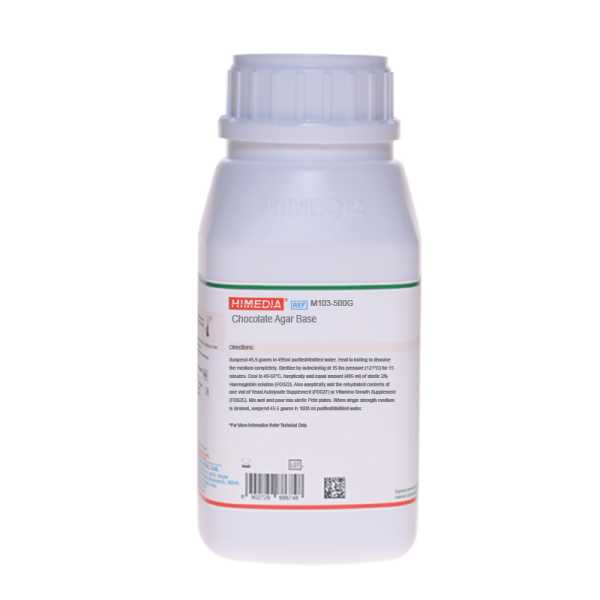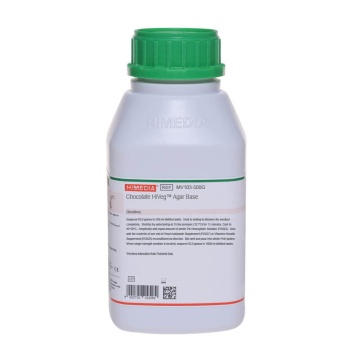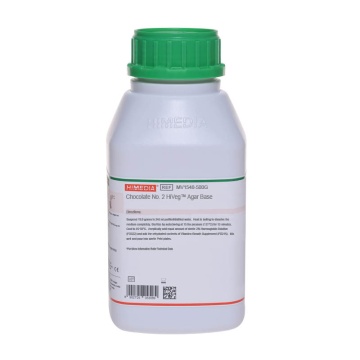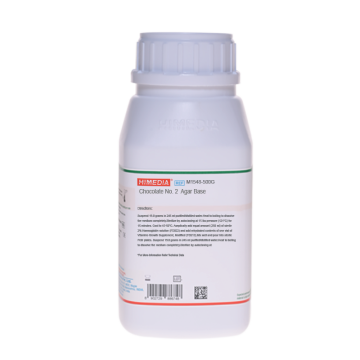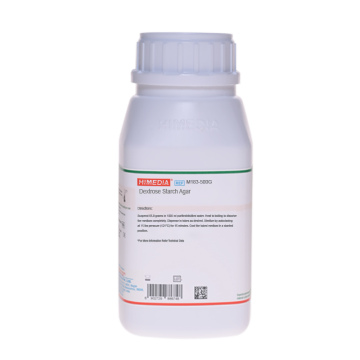 Your enquiry has been submitted
Your enquiry has been submitted
Chocolate Agar Base
Haemophilus#CC293D
Intended use
Recommended for the isolation of Neisseria gonorrhoeae from chronic and acute cases of gonococcal infections.
Composition**
| Ingredients | g/L |
|---|---|
| Proteose peptone | 20.000 |
| Dextrose (Glucose) | 0.500 |
| Sodium chloride | 5.000 |
| Disodium hydrogen phosphate | 5.000 |
| Agar | 15.000 |
| Final pH (at 25°C) | 7.3±0.2 |
**Formula adjusted, standardized to suit performance parameters
Directions
Suspend 45.5 grams in 495 ml purified/ distilled water. Heat to boiling to dissolve the medium completely. Sterilize by autoclaving at 15 lbs pressure (121°C) for 15 minutes. Cool to 45-50°C. Aseptically add equal amount (495 ml)of sterile FO Growth Supplement (FD022). Also add the contents or one vial of Yeast Autolysate Supplement (FD027) or Vitamino Growth Supplement (FD025) reconstituted as directed. Mix well and pour into sterile Petri plates. When single strength medium is desired, suspend 45.5 grams in 1000 ml distilled water.
Principle And Interpretation
Neisseria gonorrhoeae is a gram-negative bacteria and the causative agent of gonorrhea, however it is also occasionally found in the throat. The cultivation medium for gonococci should ideally be a rich nutrients base with blood, either partially lysed or completely lysed. The diagnosis and control of gonorrhea have been greatly facilitated by improved laboratory methods for detecting, isolating and studying N. gonorrhoeae.
Chocolate Agar Base, with the addition of supplements, gives excellent growth of the gonococcus without overgrowth by contaminating organisms. G.C. Agar (M434) can also be used in place of Chocolate Agar Base, which gives slightly better results than Chocolate Agar (1). The diagnosis and control of gonorrhea have been greatly facilitated by improved laboratory methods for detecting, isolating and studying N. gonorrhoea. Interest in the cultural procedure for the diagnosis of gonococcal infection was stimulated by Ruys and Jens, Mcleod and co-workers (2), Thompson (3), Leahy and Carpenter (4), Carpenter, Leahy and Wilson (5) and Carpenter (6), who clearly demonstrated the superiority of this method over the microscopic technique. Chocolate Agar Base with addition of supplement not only supports the growth of the gonococcus in pure culture but also permits its development from the mixed flora encountered in chronic gonococcal infections. Carpenter (7) reported that this medium and Haemoglobin (FD022) is useful for cultural detection of the Gonococcus.
Type of specimen
Clinical samples - urethral swabs, urine samples.
Specimen Collection and Handling:
For clinical samples follow appropriate techniques for handling specimens as per established guidelines (5,6).
After use, contaminated materials must be sterilized by autoclaving before discarding.
Warning and Precautions :
In Vitro diagnostic Use only. For professional use only. Read the label before opening the container. Wear protective gloves/protective clothing/eye protection/ face protection. Follow good microbiological lab practices while handling specimens and culture. Standard precautions as per established guidelines should be followed while handling clinical specimens. Safety guidelines may be referred in individual safety data sheets.
Limitations
- Individual organisms differ in their growth requirement and may show variable growth patterns on the medium.
- Each lot of the medium has been tested for the organisms specified on the COA. It is recommended to users to validate the medium for any specific microorganism other than mentioned in the COA based on the user's unique requirement.
- Further biochemical and serological tests must be carried out for complete identification.
Performance and Evaluation
Performance of the medium is expected when used as per the direction on the label within the expiry period when stored at recommended temperature.
Quality Control
Appearance Cream to yellow homogeneous free flowing powder
Gelling Firm, comparable with 1.5% Agar gel
Colour and Clarity of prepared medium Basal medium: Light amber coloured clear to slightly opalescent gel. After addition of haemoglobin : Chocolate brown coloured opaque gel forms in Petri plates.
Reaction Reaction of 4.5% w/v aqueous solution at 25°C. pH: 7.3±0.2
pH 7.10-7.50
Cultural Response
Cultural characteristics observed with added FO Growth Supplement (FD022), Yeast autolysate Supplement (FD027) or Vitamino Growth Supplement(FD025), after an incubation at 35-37°C for 40-48 hours.
| Organism | Inoculum (CFU) | Growth | Recovery |
|---|---|---|---|
| Neisseria gonorrhoeae ATCC 19424 | 50-100 | luxuriant | >=70% |
| Neisseria meningitidis ATCC 13090 | 50-100 | luxuriant | >=70% |
| Streptococcus pneumoniae ATCC 6303 | 50-100 | luxuriant | >=70% |
| Streptococcus pyogenes ATCC 19615 | 50-100 | luxuriant | >=70% |
| Haemophilus influenzae ATCC 19418 | 50-100 | luxuriant | >=70% |
Storage and Shelf Life
Store between 10-30°C in a tightly closed container and the prepared medium at 2-8°C. Use before expiry date on the label. On opening, product should be properly stored dry, after tightly capping the bottle in order to prevent lump formation due to the hygroscopic nature of the product. Improper storage of the product may lead to lump formation. Store in dry ventilated area protected from extremes of temperature and sources of ignition Seal the container tightly after use. Product performance is best if used within stated expiry period.
Disposal
User must ensure safe disposal by autoclaving and/or incineration of used or unusable preparations of this product. Follow established laboratory procedures in disposing of infectious materials and material that comes into contact with clinical sample must be decontaminated and disposed of in accordance with current laboratory techniques (9,10).
Reference
- Carpenter C. M., Bucca M. A., Buck T. C., Casman E. P., Vhristensen C. W., Crowe E., Drew R., Hill J., Lankford L. E., Morton H.E., Peizer L. R., Shaw C. J., and Thayer J. D., 1949, Am. J. Syphil. Gonorrh. Veneral Diseases, 33:164
- McLeod J. W., Cootes J. C., Happold F. C., Priestely D. P., Wheatley B., 1934, J. Path. Bacteriol., 39:221.
- Muench. Wochschr., 80:846:1933
- J.Infectious Diseases, 61:129:1937
- Am. J. Syphillis, 20:347:1936
- Am. J. Syphillis, 22:55:1938
- Seventh Annual Year book (1936-37) P.133, supple., Am. J. Pub.Health.27: no.3 : 1937
- Bull. Genitoinfectious diseases, Mass. State Health Dept., 2:1:1938.
- Isenberg, H.D. Clinical Microbiology Procedures Handbook 2nd Edition.
- Jorgensen, J.H., Pfaller, M.A., Carroll, K.C., Funke, G., Landry, M.L., Richter, S.S and Warnock., D.W. (2015) Manual of Clinical Microbiology, 11th Edition. Vol. 1.
| Product Name | Chocolate Agar Base |
|---|---|
| SKU | M103 |
| Product Type | Regular |
| Physical Form | Powder |
| Origin | Animal |
| Packaging type | HDPE |
| References | 1. Carpenter C. M., Bucca M. A., Buck T. C., Casman E. P., Vhristensen C. W., Crowe E., Drew R., Hill J., Lankford L. E.,Morton H. E., Peizer L. R., Shaw C. J., and Thayer J. D., 1949, Am. J. Syphil. Gonorrh. Veneral Diseases, 33:164 2.Muench. Wochschr., 80:846:1933 3.McLeod J. W., Cootes J. C., Happold F. C., Priestely D. P., Wheatley B., 1934, J. Path. Bacteriol., 39:221. 4.J.Infectious Diseases, 61:129:1937 5.Am. J. Syphillis, 20:347:1936 6.Am. J. Syphillis, 22:55:1938 9.Isenberg, H.D. Clinical Microbiology Procedures Handb0ook. 2nd Edition.10.Jorgensen,J.H., Pfaller , M.A., Carroll, K.C., Funke, G., Landry, M.L., Richter, S.S and Warnock., D.W. (2015)Manual of Clinical Microbiology, 11th Edition. Vol. 1. |
| Customized Product Available | No |



